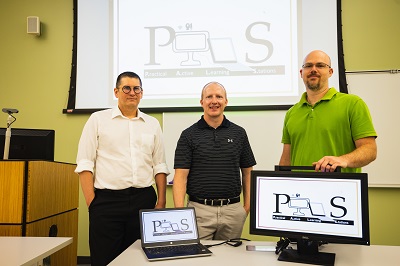Classy Collaboration
 Dr. Matthew Johnson to study a cost-efficient alternative to Active Learning Classrooms (ALCs). After three years of data collection, the team found that classrooms equipped with economical Practical Active Learning Stations (PALS) function just as well as, if not better than, expensive ALCs, raising the question of investment payoff for expensive ALCs.
Dr. Matthew Johnson to study a cost-efficient alternative to Active Learning Classrooms (ALCs). After three years of data collection, the team found that classrooms equipped with economical Practical Active Learning Stations (PALS) function just as well as, if not better than, expensive ALCs, raising the question of investment payoff for expensive ALCs.
ALCs are high-tech classrooms, most commonly used in STEM education, designed to promote student collaboration and support engaging teaching methods. Unlike traditional classrooms, ALCs utilize a group-centric layout comprised of technology-equipped desks that surround the instructor. Curious about economic ALC alternatives, Dr. Eickholt, Dr. Seeling, and Dr. Johnson conducted a study to determine if the classroom setup affected students’ academic performance.
To begin, the research team converted a traditional computer lab on CMU’s campus to a cost-efficient version of an ALC called Practical Active Learning Stations (PALS). Using controlled variables such as the same instructor, textbooks, test materials, and assignments, two Computer Science courses were taught in three different environments: PALS, ALCs, and a traditional classroom. Throughout the three-year study, students' test scores and final grades were collected and compared to evaluate the effectiveness of each classroom setting.
When it came to student perceptions, the research team found that male students preferred the cost-efficient PALS compared to female students who were relatively indifferent, but their academic performance was the same. Dr. Johnson shares, “We think the men liked the gritty DIY aspect of the PALS classrooms because it was familiar to them and offered a lower barrier to participation.”
In contrast, the results of the students’ academic performances were less differentiated. Students in the PALS classroom performed similarly, and in one case better than students in the ALCs and traditional classrooms. Dr. Johnson explains how unexpected this was, sharing, "The rhetoric leads you to believe that students learn better in the fancier ALCs”, he continues, “...but this is great news because educators can more easily replicate ALCs for a fraction of the cost; in our case, 1/25th the cost.”
The research conducted by Dr. Eickholt, Dr. Seeling, and Dr. Johnson proves that costly classrooms aren’t necessary for student success. Furthermore, it suggests that schools with limited resources can achieve a similar environment to ALCs but at the fraction of the cost.
At CMU We Do Research, We Do Real World
Story by ORGS intern Hailey Nelson
July 2021